BEST Dill Pickle Relish
This post may contain affiliate links. See my disclosure policy.
An easy, wonderfully versatile and utterly deeeeelicious homemade dill pickle relish recipe! Canning instructions are included so you can enjoy this relish all year long!
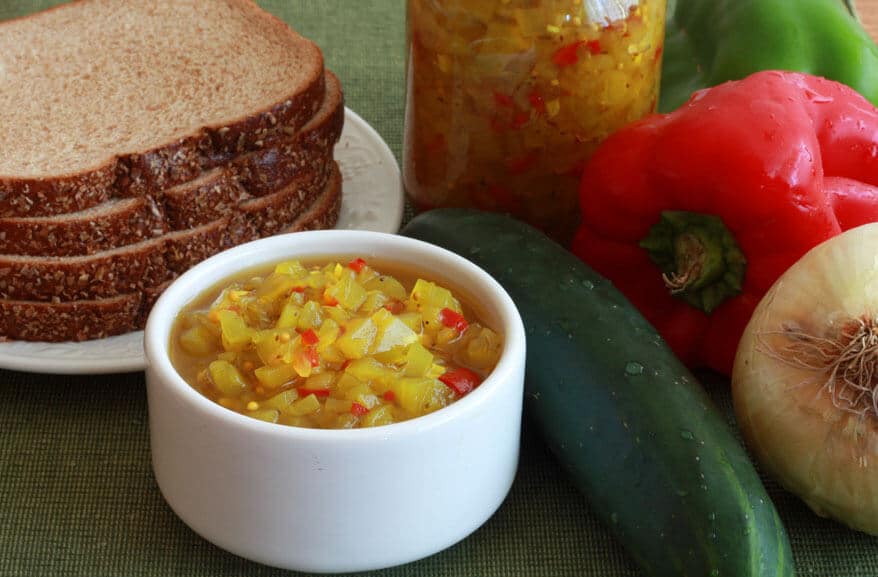
It’s relish like this that makes eating a sandwich or hot dog just that much better. It also adds a wonderful dimension to your pasta and potato salads. Last Summer I posted my recipe for Sweet Pickle Relish and here is the more savory version with a more pronounced dill flavor. It’s so easy to make and comes with instructions for canning so you can enjoy it all the year long.
Pickle Relish Recipe
Let’s get started!
We’re going to use regular cucumbers. They’re much cheaper than English cucumbers (the ones that come shrink-wrapped) or pickling cucumbers and taste exactly the same. I prefer to peel them since the peel is fairly tough. We’re also going to remove the seeds.
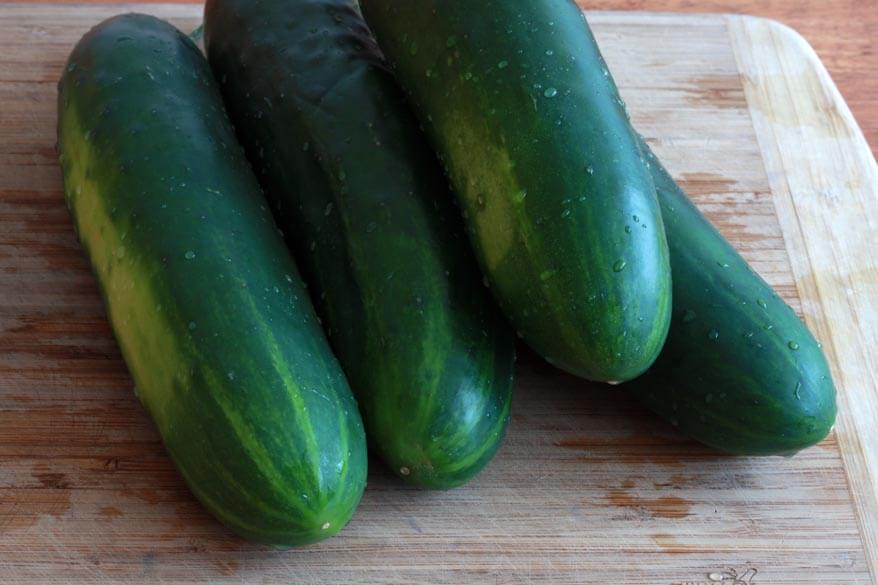
So peel the cucumbers and thinly slice them lengthwise. Slice them into strips, discarding the inner strip of seeds. Then very finely dice the cucumbers.
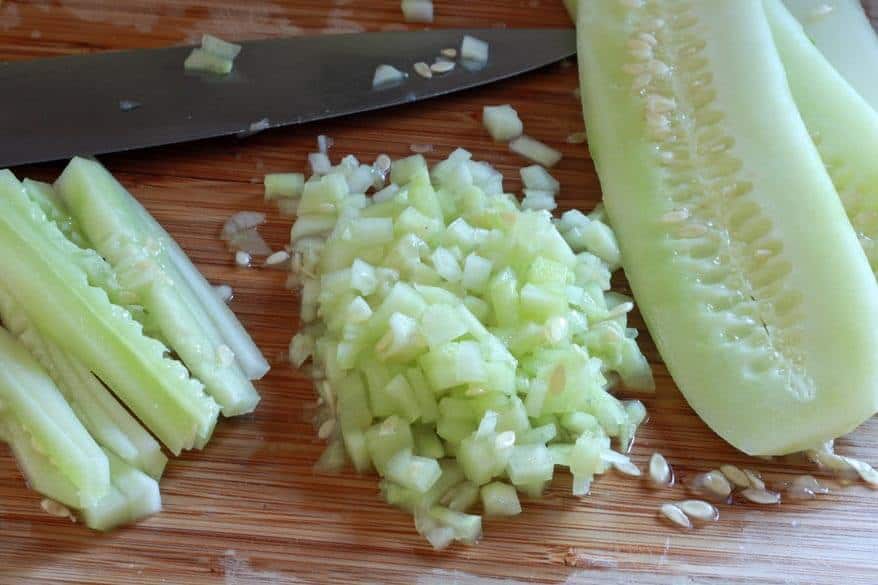
Very finely dice the onions, garlic and red bell pepper. You can use a food processor, just don’t let the onions and bell pepper get mushy. I prefer to just do it by hand.
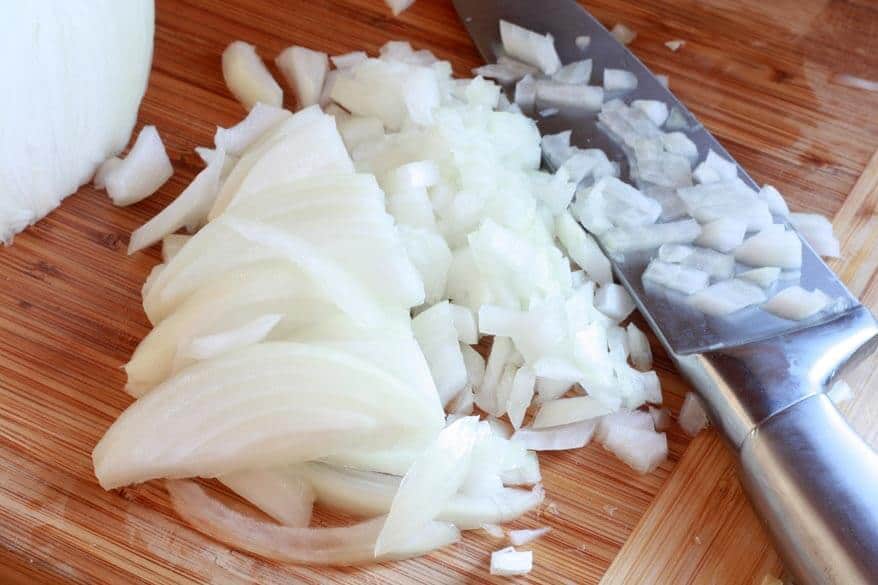
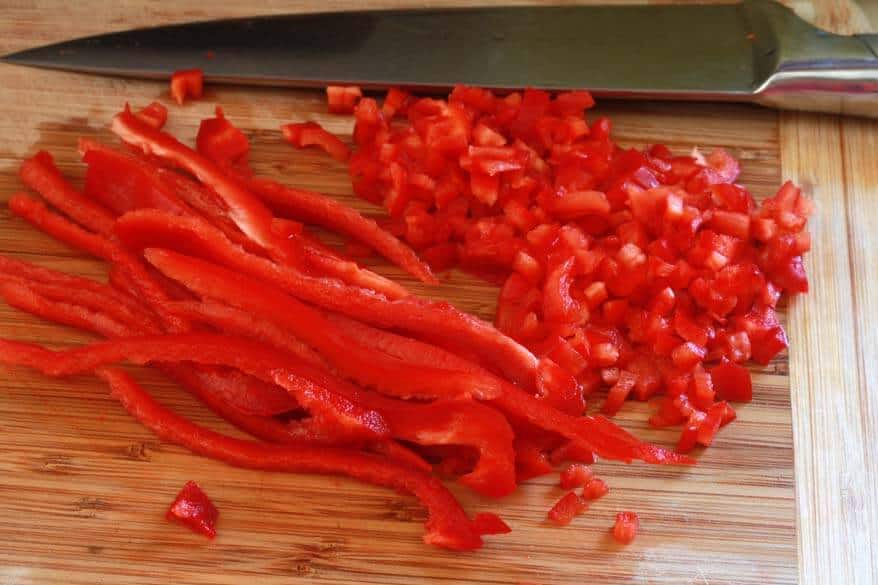
Note: There are no green bell peppers shown in the pictures and they weren’t added to this particular batch, but they belong in it. Okay, now that that’s clear, let’s move on.
Place the diced vegetables in a large bowl along with the salt. Cover with water and let it sit for at least 6 hours or overnight.
(Ignore the fact that some of the cucumber peels are on. The second batch I made I peeled the cucumbers and the result was better.)
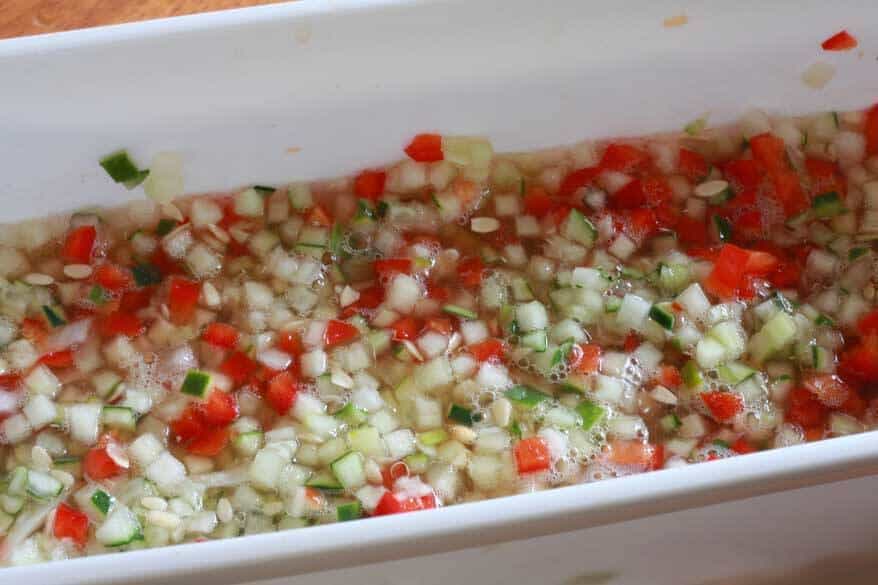
Put the sugar, vinegar and spices in a large stock pot and bring it to a boil. Reduce the heat to a low boil and simmer for 5 minutes.
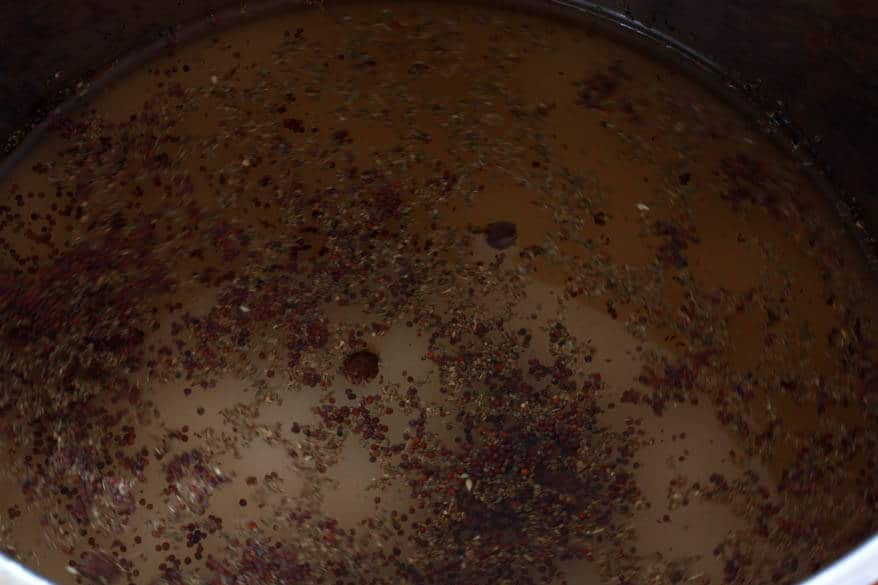
Drain the cucumber mixture in a colander, thoroughly rinse, and drain again.
Add the mixture to the stock pot. Return to a boil, reduce the heat to medium-low, and simmer, uncovered, for 10 minutes. Discard the bay leaves.
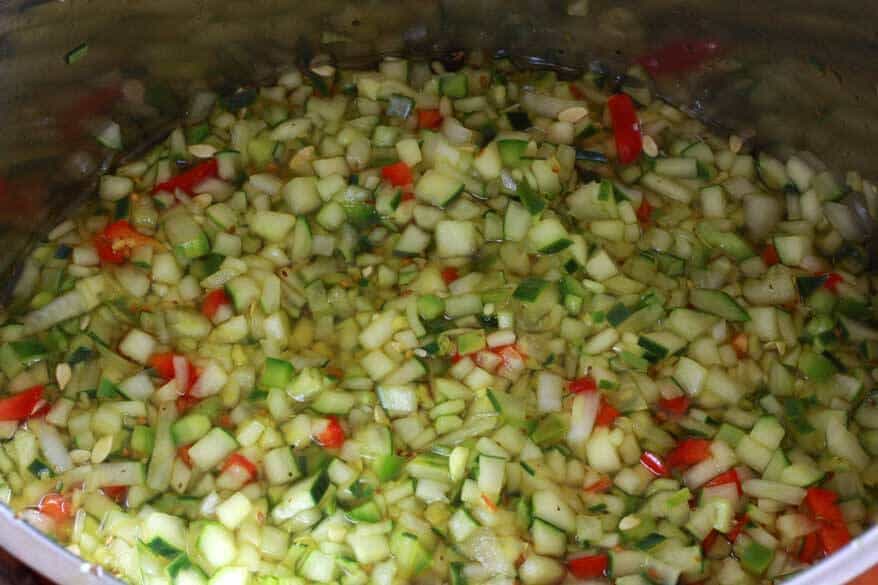
Ladle the hot relish into the hot sterilized jars, leaving 1/4 inch of headspace. Wipe the rims of the jars clean and seal tightly with the lids. Process the jars in a boiling water bath for 10 minutes.
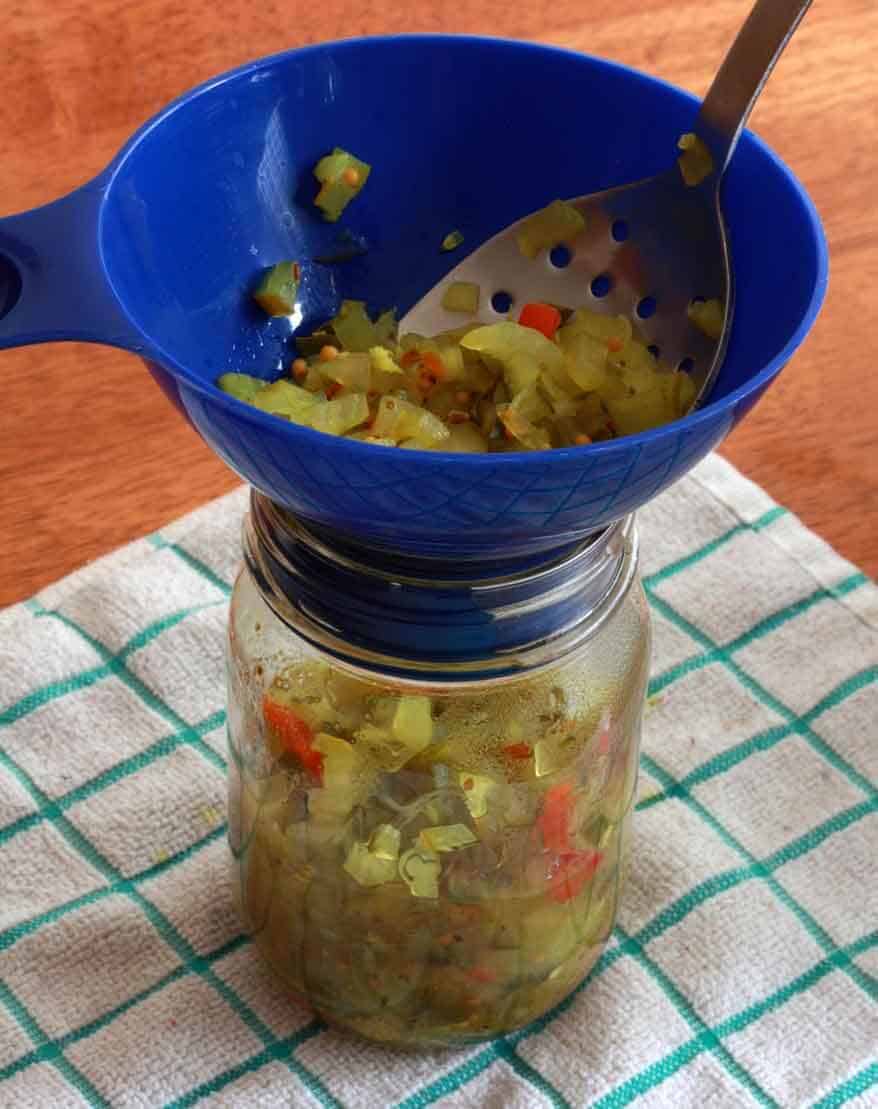
Ah, the masterpiece is done!
Best eaten at least a week later after the flavors have had time to meld and the vinegar mellows out a bit. In addition, the relish needs to sit to give it time to absorb some of the liquid and to thicken.
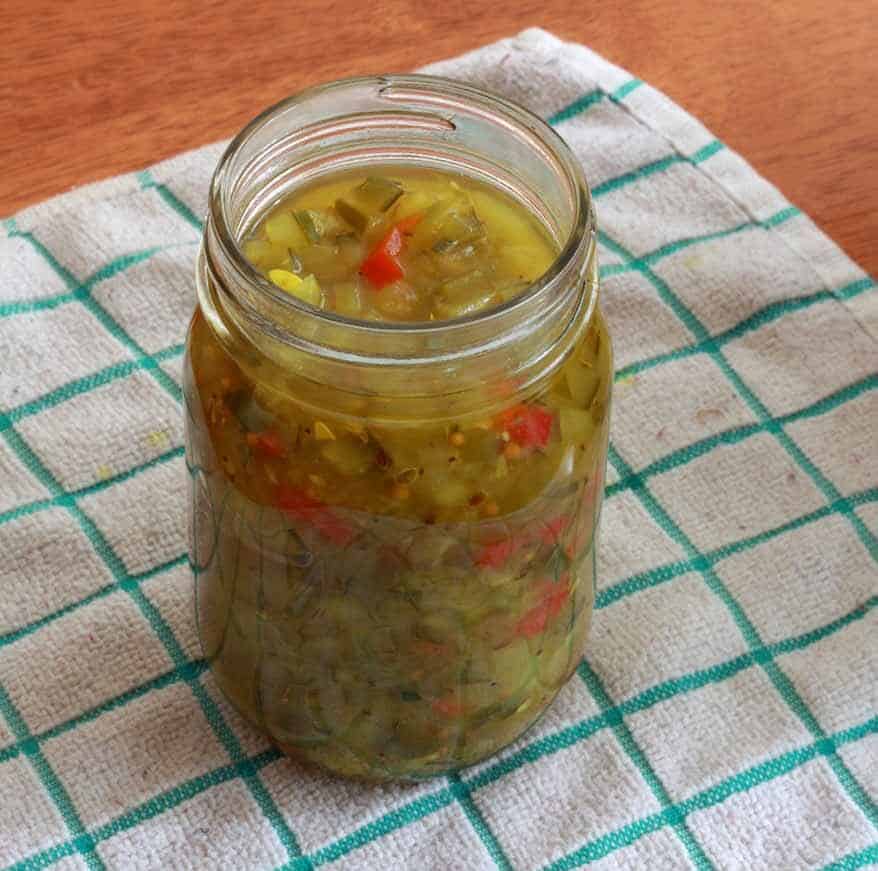
It’s so satisfying to see the end result of your labors – and you can enjoy this relish all the year long!
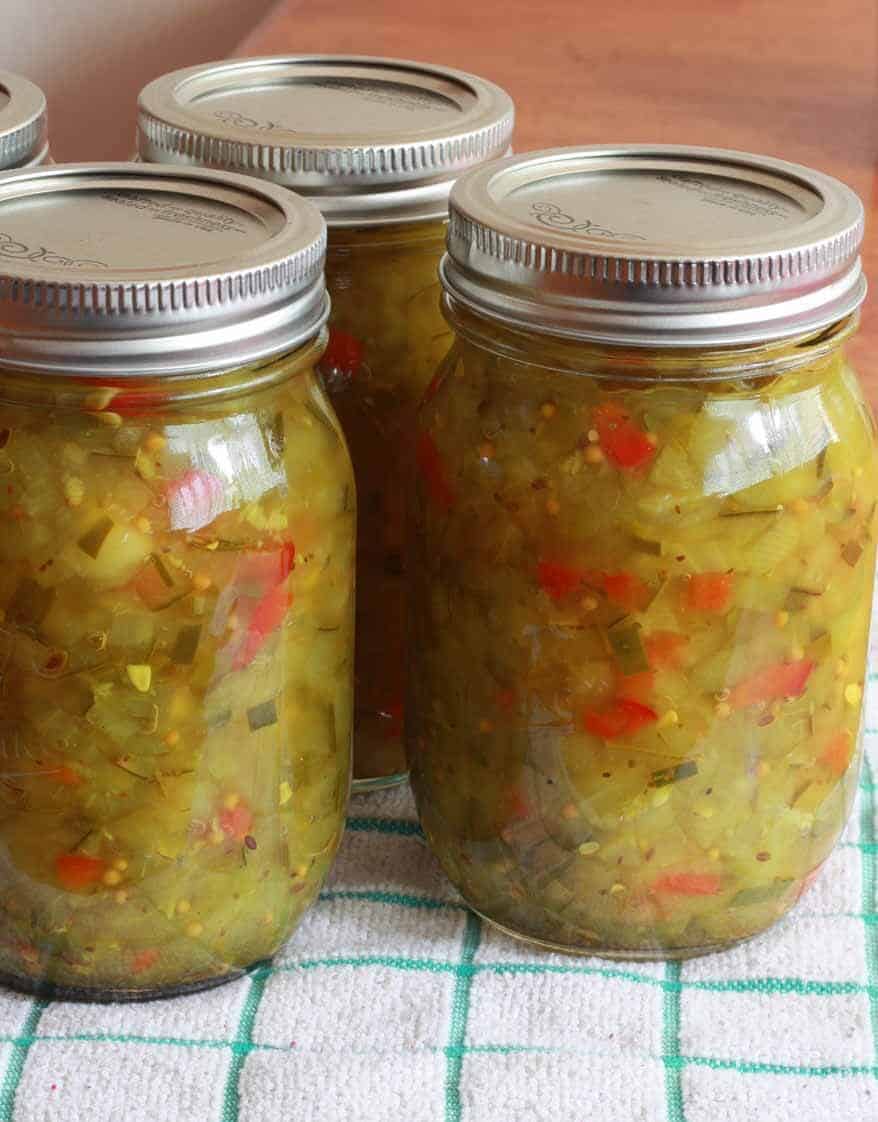
For more pickled vegetable recipes be sure to try my:
- Giardiniera
- Corn Relish
- Sweet Pickle Relish
- Pickled Pepperoncini Peppers
- Sweet Pepper and Onion Relish
- English Pickled Onions
- Pickled Banana Peppers
- Pickled Okra
- Pickled Green Beans
- Pickled Asparagus
- Pickled Turnips
- Pickled Peppers
- Pickled Beets
Save This Recipe
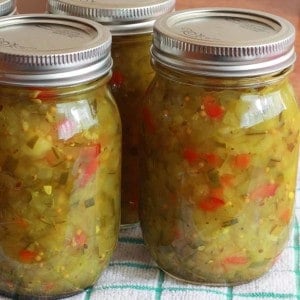
BEST Dill Pickle Relish
Equipment
Ingredients
- 2½ lbs cucumbers (weighed prior to peeling and seeding),peeled, center row of seeds removed, and finely diced
- 1 large yellow onion ,finely diced
- 1 small red bell pepper ,finely diced
- 1 small green bell pepper ,finely diced
- 3 cloves garlic ,finely minced
- ¼ cup kosher or pickling salt (neither of these have additives which is important to avoid when canning)
- 3 cups white vinegar
- 1/2 cup sugar (optional or use less according to taste)
- 2 teaspoons dill seeds
- 1 tablespoon yellow mustard seeds
- 2 teaspoons celery seeds
- 1/2 teaspoon turmeric
- 2 bay leaves
Instructions
- Place the diced cucumbers, onion, bell pepper, and garlic in a large mixing bowl. Combine with the salt and pour water over the mixture until covered. Let sit for at least 6 hours or overnight.Drain the cucumber mixture in a colander, rinse thoroughly with water, and drain again.
- In a large stock pot, add the sugar, vinegar, and spices and bring to a boil. Reduce the heat to medium-low and simmer for 5 minutes. Add the drained cucumber mixture and return to a boil. Reduce the heat to medium-low and simmer, uncovered, for 10 minutes. Discard the bay leaves.
- Ladle the hot relish into hot sterile jars, leaving ¼ inch of headspace. Wipe the rims of the jars clean and seal tightly with the lids.Process the jars in a boiling water bath for 10 minutes.
- Sealed jars will store in a cool, dark place for a year. If the seal is broken, the relish will keep in the fridge for at least a month. Makes 4 pints (you can use pint-sized or half pint jars). Best eaten at least a week later after the flavors have had time to meld and the vinegar mellows out a bit. In addition, the relish needs to sit to give it time to absorb some of the liquid and to thicken.
Nutrition
Originally published on The Daring Gourmet February 15, 2014



















Hi, I guess I should’ve read the entire recipe before I bought the spices. I assumed since it’s Dill Relish there wouldn’t have sugar in it. How do you think it would turn out without it? Has anyone reading this ever made it without the sugar? Thanks in advance!!
The recipe sounds good but the nutritional information scares me. What is the serving size?
Hi Yvonne, sorry for the scare, the nutritional information was for the entire batch (4 pints). I’ve just updated it to reflect the nutritional info per serving (one tablespoon).
I have made your recipe for dill pickles and absolutely loved it!!! Today i am making dill relish.I would like to add some corn for a few of the jars to make corn relish.Do you think it would work? ??
Hi Lori, that’s fantastic, I’m so glad you enjoyed it, thank you! Yes, you can add some corn. The main thing is not to adjust the vinegar/salt content – it needs to stay at the right pH level – but feel free to add some corn.
What is the shelf life of this particular recipe? I usually keep things I have canned myself for a year, I just worry that they will go bad.
Hi Brandy, from a safety standpoint it will keep at least a year but for optimal flavor I would eat it within 6 months.
Would this recipework if I use summer squash and zucchini instead of cucumbers?
Hi Cathryn, yes it sure will!
Once you open a sealed jar, how long will the relish last? Does it have to be consumed in a week or two or will it last a few months?
Hi Caitlyn, it will keep for a few months. Just check for mold or a bad smell and if neither are present then it’s still good.
Made this today, guess I’m hoping it gets more flavourful over time. Out of the pot, I find it too much vinegar flavour and ended up adding additional sugar to compensate. Perhaps the dill relish is just not for me :) Trying the sweet version with the rest of the veggies already prepped.
Hi Jenn, that’s the nature of relish straight from the pot, it will be acidic, but the acidity mellows over time and for that reason relish is best enjoyed a week or two later – the flavors will have had more time to meld as well.
I shredded 22 cups of zucchini this summer and put them in the freezer. Can I use the frozen zucchini, squeeze out the water and skip the salt soak? I appreciate your advice. Thank you
Hi Kellie, vegetables have a crazy ability to retain water, even when we’ve squeezed the living daylights out of them :) I would still give them the salt soak.
Hi Kimberly
I make a lot of different pickles, garlic dills, mustard, million dollar, beets, carrots, and bread and butter. Mostly my mothers fall fare award winning recipes. Your recipe looked like a new one to try. I slid the far to 14 pints and printed the recipe. Made 12 pints. Looks absolutely great, just like the pictures. Only one little problem, well not really a big problem but the taste test revealed they were a bit vinegary. Could it possibly be from using 7% rather than 5% vinegar. Maybe after the canning process and sitting a couple weeks they will be better. Love the texture and we will for use them all.
Ron
Hi Ron, thanks for the feedback. Yes, 7% will make a difference and definitely after a couple of weeks it’s better as the acidity mellows out a bit.
Hi, I couldn’t find dill seed in the uk, but just read the latest commend of dill weed?I’m a little confused, is this what we call the dull herb in the uk? Can I use dried dill? It’s all in the pan ready to go. And I used salt flakes for soaking as not sure what salt you use kosher?. I have had an abundance of mini cucumbers this year, made picked strips last week but fancied something different and came across this ideal recipe. I presume water bath the jars is the same as sterilising them in the oven? Xx
Hi Jo, yes, dill weed refers to the herb. It grows in different stages: First as green fronds (which is what you normally find in the supermarket) and then in time those will flower and go to seed. As I noted in the previous comment, it’s those flowering dill heads that are considered the most ideal for canning pickles and relish, but the green fronds of the dill can also be used as can dried dill.
Is the nutritional info per jar?
Hi LaDonna, no, it’s for the entire batch. The nutritional info box won’t let me break it down by jar.
Do you think it would turn out okay if zucchini was used instead of cucumbers? Something ate all my cucumber plants this year but i have an abundance of zucchini.
Absolutely, Nikki, zucchini relish is awesome! Nothing else needs to change, just swap the cucumbers out for zucchini.
Hi Kimberly! This is my first year canning and I’m so excited to find your recipe! I have Killebrew in my blood and when I saw your name, I thought I must try this out! I’m hoping it’s a good dill version although I read a few unhappy comments. I may try the less sugar route in hopes that works! Everything is soaking now! Have a blessed summer!
Hi LaDonna, great, let us know what you think! What is the name of the furthest back Killebrew you’re aware of? No doubt we’re related somehow – we have a lot of family history information and could probably make the connection :) Feel free to send me an email if you like at daringgourmet@yahoo.com.
This is the recipe we used last year to get rid of a surplus of cucumbers and green peppers. It was by far our favourite item that we canned and when June rolled around this year we used our last jar on some BBQ smokies and we were sad that we didn’t have any more for the summer! This year I am making loads of this recipe to share and stock pile so we have it for next summer. It really takes on an amazing flavour after a few months sitting on the canning shelf. Such a good recipe!
Fantastic, Laura, thanks so much for the feedback!
Is there a difference between dill weed and dill seed?? And is the mustard seed ground or whole?
Hi Erin, dill seed generally has a stronger flavor than fresh dill weed but you can use dill weed instead. The kind of dill weed best for canning pickles and relish are the tall stalky ones with flowering heads that you only find in the summer (specifically for canning pickles). Likewise mustard seed has a stronger flavor and also doesn’t make the liquid murky.